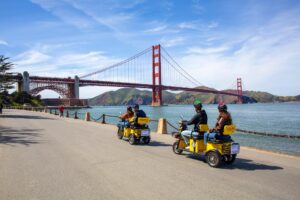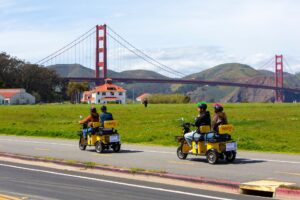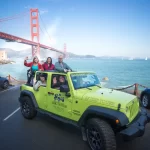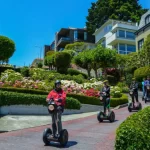Navigating the Past and Present: Hyde Street Pier and San Francisco Maritime National Historical Park
When you find yourself at the western edge of San Francisco’s vibrant Fisherman’s Wharf, a historic treasure awaits your exploration – the Hyde Street Pier and the San Francisco Maritime National Historical Park. This maritime haven is not just a collection of old ships; it’s a living testament to San Francisco’s seafaring history. In this article, we’ll dive deep into the past and present of Hyde Street Pier and the San Francisco Maritime National Historical Park, explore the fascinating ships moored there, and unearth ten fun and intriguing facts that make this destination truly special.
A Voyage Through History
The Maritime Legacy of Alma de Bretteville Spreckels
Our journey begins in the early 1950s when Alma de Bretteville Spreckels, a remarkable San Francisco figure, embarked on her last major project: the creation of the San Francisco Maritime Museum. What visitors see today had its roots in Alma’s extensive collection of model ships, first showcased at the 1939–40 Golden Gate International Exposition. Her passion for maritime history led to the museum’s establishment, but she remained in the shadows due to a feud with Karl Kortum, the founding director.
The Historic Fleet
The heart of the San Francisco Maritime National Historical Park is the Hyde Street Pier, home to an impressive fleet of historic vessels that transport you to a bygone era. Here’s a glimpse of the major vessels moored at this historic pier:
- Balclutha: An 1886 square-rigged sailing ship.
- C.A. Thayer: An 1895-built schooner.
- Eureka: An 1890 steam ferryboat.
- Alma: An 1891 scow schooner.
- Hercules: A 1907 steam tug.
- Eppleton Hall: A 1914 paddlewheel tug.
Each of these vessels has a unique story to tell, and visiting them offers a captivating glimpse into the maritime history of San Francisco.
A Hub of Learning and Discovery
The San Francisco Maritime National Historical Park is not just a static museum. It’s a dynamic center of learning and discovery with programs designed for all ages. Here’s what you can experience:
-
- Educational Programs: Engage in hands-on learning experiences that provide insights into maritime history.
- Music and Craft Programs: Immerse yourself in the arts and crafts of seafaring, and even learn a sea shanty or two.
- Ranger-led Tours: Knowledgeable park rangers are your guides to the park’s rich history, offering fascinating anecdotes along the way.
- Breathtaking Views: Don’t miss the opportunity to enjoy breathtaking views of the San Francisco Bay and the iconic Golden Gate Bridge from Hyde Street Pier. Access to the pier itself is free.
Hyde Street Pier: A Window to the Past
Historical Significance
Before the era of the Golden Gate Bridge and the San Francisco–Oakland Bay Bridge, Hyde Street Pier played a pivotal role as the primary automobile ferry terminal connecting San Francisco with Marin County to the north and the East Bay to the east. It was an integral part of U.S. Route 101 and U.S. Route 40.
Transition into a Historical Landmark
In early 1929, the Golden Gate Ferry Company merged with the Southern Pacific Railroad’s competing auto ferry system. This merger led to the birth of the “Southern Pacific-Golden Gate Ferries, Ltd.,” which took over ferry service to the Hyde Street Pier. Today, this historic pier is a cherished part of the San Francisco Maritime National Historical Park.
Exploring the Visitor Center and Maritime Museum
Visitor Center
The San Francisco Maritime National Historic Park Visitor Center, housed in a historic brick cannery warehouse at the corner of Jefferson and Hyde Streets, is a treasure trove of maritime history. Inside, you’ll discover:
-
- Maritime Interpretation: Dive deep into fascinating maritime interpretative material and unusual artifacts.
- A Walk Along the Waterfront: Experience a museum-quality walk-through exhibit that takes you on a journey through San Francisco’s historic waterfront, from the native tribes to the industrialization of the early 20th century.
- Operating Hours: The visitor center is open seven days a week from 9:30 am to 5:00 pm.
Maritime Museum
Situated across the street from Ghirardelli Square, the historic Maritime Museum building offers stunning views of San Francisco Bay, from the Golden Gate Bridge to Alcatraz Island. Here’s what you can expect:
-
- Art Deco Beauty: The museum building, constructed in 1938 as a WPA economic recovery project, is a splendid example of Art Deco style, adorned with mural paintings and unique architectural motifs.
- Nautical Artifacts: Inside, you’ll find a collection of nautical artifacts, models, and exhibits that showcase the maritime history of the region.
- Event Venue: The museum is also a stunning venue for special events, from weddings to gala celebrations.
- Operating Hours: It’s open daily from 10:00 am to 4:00 pm.
Fun and Fascinating Facts
Before we conclude our maritime journey, let’s unearth ten fun and intriguing facts about Hyde Street Pier and the ships that call it home:
- Floating Classroom: The historic vessels on Hyde Street Pier serve as floating classrooms, providing visitors with a hands-on maritime education.
- Eppleton Hall’s Journey: Eppleton Hall, the paddlewheel tug, embarked on a remarkable journey from England to San Francisco, crossing the Atlantic Ocean and traversing the treacherous Panama Canal.
- Eureka’s Renovation: The steam ferryboat Eureka underwent extensive renovations to restore it to its former glory, including its iconic triple-expansion steam engine.
- National Park Service Ownership: The San Francisco Maritime Museum’s collections were acquired by the National Park Service in 1978.
- Aquatic Park Historic District: The park also incorporates the Aquatic Park Historic District, a designated National Historic Landmark.
- Historic Landmark Status: The visitor center’s brick warehouse is a historic landmark, listed on the National Register of Historic Places since 1975.
- The ’48 Gold Rush: Some of the vessels in the fleet, like Balclutha, have stories dating back to the California Gold Rush of 1848.
- Pioneer in Preservation: The park is a pioneer in the preservation of historic ships, ensuring they remain a living part of San Francisco’s history.
- Ferry Tales: Before becoming a historical site, Hyde Street Pier was a bustling ferry terminal connecting the city to Marin County.
- A Living Museum: San Francisco Maritime National Historical Park is one of the few places where you can step aboard and explore historic vessels that once sailed the world’s oceans.
Chart Your Course to Hyde Street Pier
Visiting Hyde Street Pier and the San Francisco Maritime National Historical Park is more than a visit to a museum; it’s a voyage through time. Whether you’re a history enthusiast or simply seeking a unique experience in San Francisco, make sure to add this iconic destination to your itinerary. Immerse yourself in the city’s maritime heritage, explore the historic vessels, and let the tales of the sea transport you to a different era.
Exploring the Historic Ships at Hyde Street Pier
Delve into these maritime marvels docked on the city’s waterfront. Get ready to set sail on a journey through time!
The Balclutha – A Tale of Trade and Transformation
- Fact 1: Balclutha, with its steel-hulled beauty, was born in 1886. She’s seen it all – from lumber to salmon, and even grain. Talk about a versatile ship!
- Fact 2: This vessel has braved the treacherous waters around Cape Horn not once, not twice, but 17 times in just 13 years. Now, that’s some serious seafaring.
- Fact 3: Balclutha was a true globetrotter, shuttling between Europe, the East Coast of the United States, and ports in the Pacific. From Chile to Australia, she carried it all!
- Fact 4: In 1904, she underwent a remarkable transformation, becoming the “Star of Alaska” and ventured into the salmon fishing trade. Crew size skyrocketed from 26 to 200+!
- Fact 5: After her stint in the movies and a short-lived career as a “pirate ship,” Balclutha found a new home at San Francisco Maritime National Historical Park in 1954. It’s where her legacy lives on.
C.A. Thayer – The Lumber Schooner Extraordinaire
- Fact 1: Built in 1895, C.A. Thayer hailed from Eureka, California. She was a lumber schooner on a mission, carrying wood from Washington, Oregon, and Northern California to San Francisco.
- Fact 2: Imagine stacking lumber 10 feet high on her deck – that’s how she rolled! And those eight to nine crew members? They had their hands full.
- Fact 3: After a run-in with a gale, C.A. Thayer shifted gears in 1912 and became a vital part of the Alaskan salmon fishery. She had quite the busy summers.
- Fact 4: In the 1920s, she embraced cod fishing in Alaska’s Bering Sea, with fishermen hauling in hundreds of cod per day. Talk about a seafood bounty!
- Fact 5: World War II led to a change in career again. She became an ammunition barge, doing her part for the war effort.
Eureka – The Paddlewheel Steamboat Marvel
- Fact 1: Eureka set sail in 1890 and, fun fact, she’s the largest wooden ship worldwide. Quite the feather in her cap!
- Fact 2: Originally, she ferried folks between San Francisco and Tiburon. But as automobiles gained popularity, she transformed to carry vehicles and passengers.
- Fact 3: During World War I, she carried munition-filled rail cars, and her hull had to undergo major reconstruction. “Jacking up the whistle and sliding a new boat underneath” – sounds like a challenge!
- Fact 4: Eureka made daily commuter runs between Sausalito and San Francisco in the 1920s, handling a whopping 2,200 passengers per trip.
- Fact 5: The completion of the Golden Gate Bridge in 1937 spelled the end for ferry service, and Eureka took on a new role, linking cross-country trains until 1957.
Alma – The Delta Scow Schooner
- Fact 1: Alma, born in 1891, was a flat-bottomed scow schooner designed for navigating the shallow creeks and rivers around San Francisco Bay.
- Fact 2: She was all about hauling goods, from hay to lumber. After 1918, she took on salt as cargo and even tried her hand at oyster dredging.
- Fact 3: Alma is a unique survivor, representing a type of vessel that once thrived all over the United States.
- Fact 4: California saw her potential and began restoring her in 1964, leading to her National Register of Historic Places recognition in 1975.
- Fact 5: Alma now proudly stands as an exhibit at the San Francisco Maritime National Historical Park.
Hercules – The Mighty Steam Tug
- Fact 1: Hercules was born in 1907 and served as an oceangoing tug, towing ships up and down the coast from San Francisco.
- Fact 2: She even hauled timber from the Pacific Northwest to Southern California mills. Now that’s a tug with muscle!
- Fact 3: During World War I, Hercules had a stint transporting munition-filled rail cars. Talk about a high-stakes job!
- Fact 4: By the 1950s, she linked cross-country trains, and her service continued until 1958.
- Fact 5: Hercules found her forever home at San Francisco Maritime National Historical Park after being donated in 1979.
Eppleton Hall – A Transatlantic Adventure
- Fact 1: Eppleton Hall, built in 1914, was a pioneering paddlewheel tugboat designed for towing seagoing colliers.
- Fact 2: She was one of the last of her kind and had the power to turn on a dime. Now that’s maneuverability!
- Fact 3: The tug changed hands several times, ending up in the care of the Seaham Harbour Dock Company.
- Fact 4: Her incredible journey began in 1969 when she was restored for a transatlantic voyage to San Francisco, via the Panama Canal.
- Fact 5: Today, Eppleton Hall rests at Hyde Street Pier, a testament to maritime adventure and perseverance.
So, fellow travelers, if you’re ever in San Francisco, don’t miss the chance to explore these historic ships that have weathered storms, transformed industries, and left an indelible mark on the city’s maritime history. Set your course for a voyage through time!







